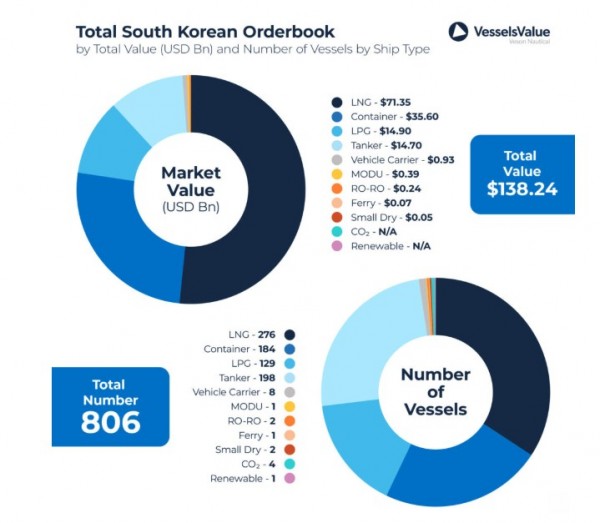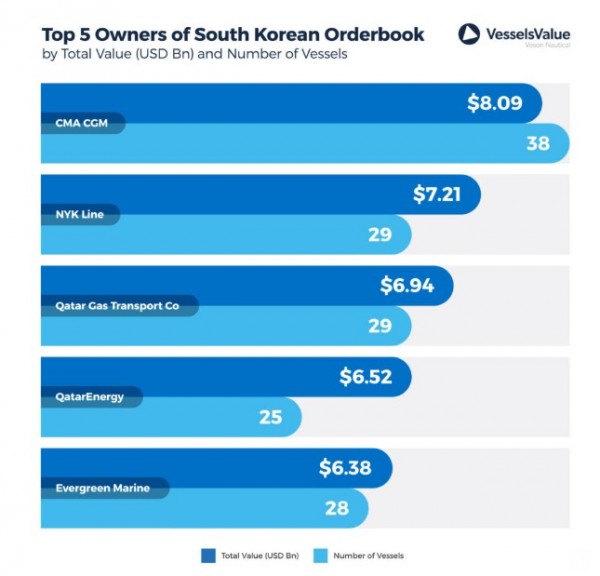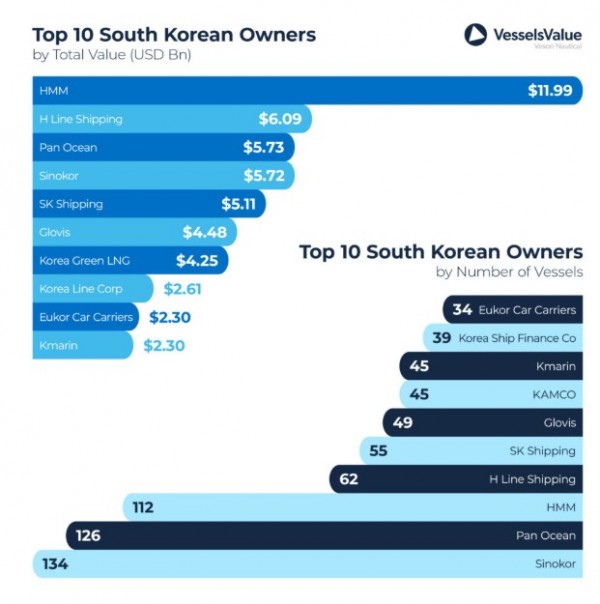Feature Story South Korea's orderbook tops $138 billion with LNG sector sweeping 52%
페이지 정보
작성자 최고관리자 댓글 0건 조회 24회 작성일 25-04-05 13:55본문
South Korea's orderbook tops $138 billion with LNG sector sweeping 52%
- Gas carriers dominate list with 276 vessels on order
Using data from Veson Nautical solution VesselsValue, we break down the South Korean orderbook by number of vessels and market value, highlighting the top five owners within the orderbook, the percentage of the fleet being ordered with dual-fuel capabilities, and the top 10 owners based in South Korea.
Within the South Korean orderbook, the LNG sector is the most valuable, worth USD 71.3 Bn and accounting for around 52% of the total South Korean orderbook value. This sector also has the highest volume of orders with 276 vessels on order.
Containers rank second with a market value of USD 35.6 Bn—equating to a share of c.26% and 184 vessels on order. The LPG ranks third with a value of USD 14.9 Bn and 129 vessels on order, closely followed by the Tanker orderbook which is valued at USD 14.7 Bn. Tankers surpass both LPG and Containers in volume with 185 vessels scheduled to be built. Vehicle Carriers rank fifth with a value of USD 929 mil and a total of eight vessels on order.
CMA CGM is in first place with a total of USD 8.09 Bn on order, and they have the highest volume of orders consisting exclusively of 38 Container vessels within the ULCV, New Panamax, and Post Panamax sectors.
In second place, NYK has a total of USD 7.21 Bn on order which includes 26 Large LNG vessels of 174,000 CBM and three VLACs of 88,000 CBM. In addition to these vessels on order in South Korea, NYK has a further 56 vessels on order in Chinese, Japanese, and German yards, including additional orders for LNG, LPG orders, Bulkers, and Tankers.
Qatar Gas Transport ranks third in value with an orderbook worth USD 6.9 Bn, consisting of 29 vessels primarily of the Large and Qmax LNG sectors.
Qatar Energy is ranked fourth with an orderbook value of USD 6.52 Bn, consisting of 25 Large LNG vessels of 174-175,000 CBM.
With a total orderbook value of USD 6.38 Bn, Evergreen Marine Corppration ranks fifth. The 28 vessels on order are all New Panamax Containers of 15,372 – 15,500 TEU or ULCVs of 24,000 TEU. They are followed by MOL with an orderbook value of USD 5.62 Bn and a total of 26 vessels on order.
Of the vessels on order in South Korea, approximately 37% are being fitted with dual-fuel capabilities, with a market value of USD 71.4Bn. With the exception of LNG carriers which will always be dual fuel, this includes all Vehicle Carriers and Ro-Ro’s.
The second highest percentage is the Container sector where 148 dual-fuel vessels have been contracted, equating to c.80% of the orderbook. Approximately 50% of the LPG orderbook, or 64 vessels, will be built as dual fuel, with a market value of USD 7.5 Bn.
Of the top owners in South Korea, taking into account both the live fleet and on order, HMM has the most valuable fleet worth an impressive USD 11.9 Bn and a total of 112 vessels spanning across the Bulker, Tanker, Container, LNG and Vehicle Carrier sectors. This is a relatively modern fleet with an average age of eight years.
H Line Shipping are in second place with a fleet value of USD 6.09 Bn and 62 vessels. Pan Ocean ranks third with a fleet value of USD 5.73 Bn, coming in second for the largest fleet, with 126 vessels; however, Sinokor, who rank fourth in terms of value, worth USD 5.73 Bn, have the largest fleet in terms of volume with 134 vessels. The average age of this fleet is slightly older, with an average age of 11 years, compared to HMM who top the board with a fleet value double that of Sinokor. More than half of this fleet in the Container sector is just over c.54% but also includes Tankers, Bulkers, and LNG.
South Korea’s shipbuilding industry remains a global leader, with a diverse orderbook dominated by LNG carriers, Tankers, and Containers. The shift towards dual-fuel vessels is significant, particularly in the Container and LPG sectors. Top owners like Qatar Energy, CMA CGM, and NYK are driving demand for large LNG and container vessels. South Korea’s fleet owners, including HMM and H Line Shipping, continue to lead in both fleet value and size, cementing the country’s pivotal role in the future of global shipping.
■ Contact: Veson Nautical www.veson.com
















